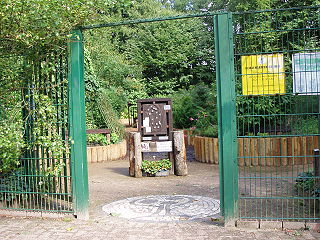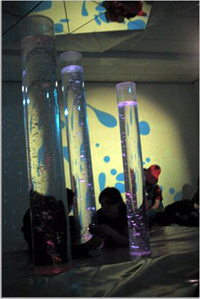Occupational therapists (OTs) are health care professionals specializing in occupational therapy and occupational science. OTs and occupational therapy assistants (OTAs) use scientific bases and a holistic perspective to promote a person's ability to fulfill their daily routines and roles. OTs have training in the physical, psychological, and social aspects of human functioning deriving from an education grounded in anatomical and physiological concepts, and psychological perspectives. They enable individuals across the lifespan by optimizing their abilities to perform activities that are meaningful to them ("occupations"). Human occupations include activities of daily living, work/vocation, play, education, leisure, rest and sleep, and social participation.

Music therapy, an allied health profession, "is the clinical and evidence-based use of music interventions to accomplish individualized goals within a therapeutic relationship by a credentialed professional who has completed an approved music therapy program." It is also a vocation, involving a deep commitment to music and the desire to use it as a medium to help others. Although music therapy has only been established as a profession relatively recently, the connection between music and therapy is not new.

Occupational therapy (OT) is a healthcare profession that involves the use of assessment, intervention, consultation, and coaching to develop, recover, or maintain meaningful occupations of individuals, groups, or communities. The field of OT consists of health care practitioners trained and educated to support mental health and physical performance. Occupational therapists specialize in teaching, educating, and supporting participation in activities that occupy an individual's time. It is an independent health profession sometimes categorized as an allied health profession and consists of occupational therapists (OTs) and occupational therapy assistants (OTAs). OTs and OTAs have different roles, with OTs licensed to complete comprehensive occupational therapy evaluations. Both professionals work with people who want to improve their ability to participate in meaningful occupations.

Art therapy is a distinct discipline that incorporates creative methods of expression through visual art media. Art therapy, as a creative arts therapy profession, originated in the fields of art and psychotherapy and may vary in definition. Art therapy encourages creative expression through painting, drawing, or modelling. It may work by providing a person with a safe space to express their feelings and allow them to feel more in control over their life.

A sensory garden is a self-contained garden area that allows visitors to enjoy a wide variety of sensory experiences. Sensory gardens are designed to provide opportunities to stimulate the senses, both individually and in combination, in ways that users may not usually encounter.
Healing environment, for healthcare buildings describes a physical setting and organizational culture that supports patients and families through the stresses imposed by illness, hospitalization, medical visits, the process of healing, and sometimes, bereavement. The concept implies that the physical healthcare environment can make a difference in how quickly the patient recovers from or adapts to specific acute and chronic conditions.
Evidence-based design (EBD) is the process of constructing a building or physical environment based on scientific research to achieve the best possible outcomes. Evidence-based design is especially important in evidence-based medicine, where research has shown that environment design can affect patient outcomes. It is also used in architecture, interior design, landscape architecture, facilities management, education, and urban planning. Evidence-based design is part of the larger movement towards evidence-based practices.

Snoezelen or controlled multisensory environment (MSE) is a therapy for people with autism and other developmental disabilities, dementia or brain injury. It consists of placing the person in a soothing and stimulating environment, called the "Snoezelen room", a form of sensory room. These rooms are specially designed to deliver stimuli to various senses, using lighting effects, color, sounds, music, scents, etc. The combination of different materials on a wall may be explored using tactile senses, and the floor may be adjusted to stimulate the sense of balance. The person is usually accompanied by an aide or therapist.
Alexandra Hospital (AH) is a rural general hospital located in Queenstown, Singapore that provides acute and community care under the National University Health System.

Horticultural therapy involves using gardening activities to promote human healing and rehabilitation.
Bagadilico, Basal Ganglia Disorders Linnaeus Consortium, is a research group in Lund, Sweden, and a Linnaeus environment, supported by the Swedish Research Council. The group comprises about 120 researchers at either Lund University or Lund University Hospital.
Magee Rehabilitation Hospital, part of Jefferson Health, founded in 1958, is a 96-bed specialty medical rehabilitation hospital providing physical and cognitive rehabilitation services. Magee's flagship facility is located in Center City Philadelphia. In addition to the main campus that offers comprehensive services for spinal cord injury, brain injury, stroke, orthopaedic replacement, amputation, pain management and work injury, Magee provides an expanding outpatient network serving the surrounding communities.
A sensory room is a special room designed to develop a person's sense, usually through special lighting, music, and objects. It can be used as a therapy for children with limited communication skills.

Gardening Leave was a British registered horticultural therapy charity that focused on the mental health of British Armed Forces veterans. It supported veterans with a wide range of mental health conditions including depression, anxiety and posttraumatic stress disorder (PTSD). Through horticultural therapy sessions, the charity aimed to maximise a veteran's physical, psychological and social strength, and enhance general health and well-being.

Midpark Hospital is a modern acute mental health unit located in Dumfries. The hospital is managed by NHS Dumfries and Galloway.

Serene Oasis is a garden on Kwun Tong Road in Kowloon, Hong Kong. Launched in 2010 for a two-year trial period for horticulture therapy, Serene Oasis opened more broadly to the public in 2013. It is the first and largest garden in Hong Kong used for horticulture therapy. Its major goal is to improve the condition of people suffering from mental illnesses such as dementia and depression. The garden has more than 100 species of plants.
Clare Cooper Marcus is a prominent educator in landscape architecture and architecture and a pioneer in the field of social issues in housing, open space design, and healing landscapes.

Bloomfield Hospital is a heritage-listed former psychiatric hospital at Forest Road, Orange, City of Orange, New South Wales, Australia. It was designed by Walter Liberty Vernon and George McRae and built from 1923 to 1931. It is also known as Orange Mental Hospital. The property is owned by NSW Health. It was added to the New South Wales State Heritage Register on 10 March 2006.

Herbert R. Schaal is an American landscape architect, educator, and firm leader notable for the broad range and diversity of his projects, including regional studies, national parks, corporate and university campuses, site planning, botanical gardens, downtowns, highways, cemeteries, and public and private gardens. Schaal is one of the first landscape architects to design children's gardens, beginning in the 1990s with Gateway Elementary, Gateway Middle, and Gateway Michael Elementary school grounds in St. Louis, Missouri, the Hershey Children's Garden at the Cleveland Botanical Gardens, and Red Butte Garden and Arboretum.
Medical ethnomusicology is a subfield of ethnomusicology, which according to UCLA professor Timothy Rice is "the study of how and why humans are musical." Medical ethnomusicology, similar to medical anthropology, uses music-making, musical sound, and noise to study human health, wellness, healing and disease prevention including, but not limited to, music as violence.











